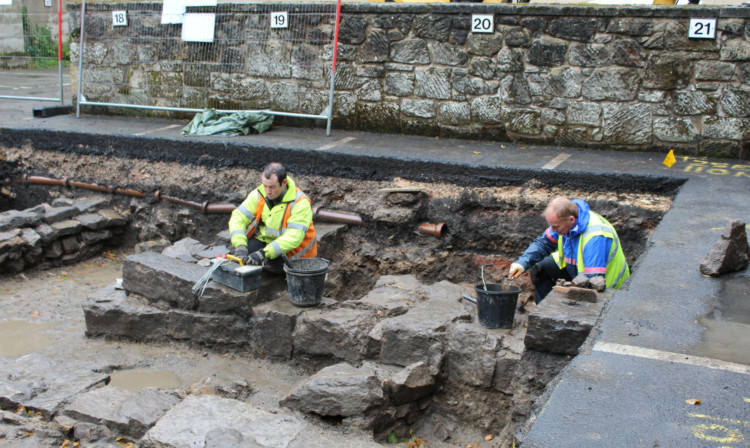A medieval midden and a smokeless stove are helping to shed new light on Dunfermline’s fascinating past.
Before work gets under way on the ancient capital’s new £10.8 million museum and art gallery next spring, a team of archaeologists led the community in Dig Dunfermline.
And the professionals and team of 83 volunteers who poured painstakingly over the dig for a collective total of 286 days have come up with new discoveries which in many ways are changing the current thinking on medieval life in what is now the heritage quarter of the town, surrounding the Abbey, monastery and Abbot House.
Thomas Rees of Rathmell Archaeology highlighted his top finds:
* Mystery building. A 2011 test dig discovered a building just to the north of the Abbey graveyard. This year’s full dig revealed only three courses of the foundations of the structure and there was very little in the way of dating evidence. However, archaeologists are confident that it is the remains of a medieval building they are just unsure what it was used for. There will be more investigation before the construction work on the new museum starts.
* Stove tile. Perhaps one of the smallest finds from the site was a small fragment of pottery identified as a stove tile, which would have formed part of a smokeless stove. North German in style, this tile is probably from the 16th Century and is a rare example of a prestigious, high quality and desirable household device. Not only does this show the wealth of some of the homes in Dunfermline, but also the trading links across the North Sea into Germany and the Baltic States;
* Leather Fragments. The “remarkable” discovery of fragments of preserved leather will provide information on how the early monastic community lived. Discovered at the very base of the excavation, within waterlogged sediment, this material will allow for accurate dating of the earliest midden deposit and has changed the understanding of this area. Such a boggy midden suggests a damper and more unpleasant environment to the east of the Abbey than was previously thought, showing the Abbey to have been sited on a rise, when approached from the east.
Fife Council archaeologist Douglas Speirs said: “It was so encouraging to see the project team commit sufficient resources to undertake such a thorough archaeological excavation.
“Combining planning requirements with the public’s enormous appetite for local heritage has surpassed expectations and resulted in real, immediate and tangible benefits for the whole community.
“Due almost entirely to the hard work of the scores of volunteers, we have shed more light on Dunfermline’s medieval past than any previous excavation.
“The project is contributing a great deal to the history, identity and future economic potential of Dunfermline as a premier cultural destination and this dig is already being hailed as an exemplar approach in community archaeology.”
City of Dunfermline committee chairwoman Helen Law added: “I think these are excellent and exciting discoveries that show what can be revealed when we excavate within an important burgh.
“The dig was a real community effort that created a lot of interest in what was going on and I’m thrilled that so many local people have already been involved in helping make the new museum and art gallery a reality.”
For those who are interested in finding out more about the dig, the archaeologists and volunteers who took part are holding a post-dig seminar on Wednesday in the Carnegie Conference Centre from 1pm to 5pm.
It is free but tickets must be reserved at Carnegie Hall box office or online at www.onfife.com/box-office.
